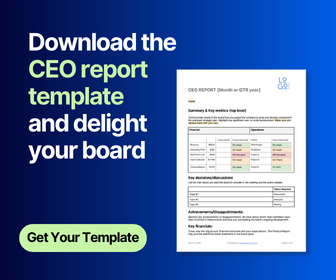How should a Chief Executive Report to the Board?
Many chief executives complain about their boards. They use terms like ‘meddling’ and ‘crossing the line’. They also lament that their boards spend too much time on the details and are not strategic enough. Whether you like it or not, you’re unlikely to be able to change your board, but rather, your board can change you! In the end, the best way to manage and impact the board dynamics is to succeed in your role.
This guide covers:
It is certainly not uncommon or unhealthy for your board to have an established pattern of reporting when you arrive as CEO. However, the shape and flavour of reporting to the board can be changed (or redesigned) over time.
The answer will frequently lie in taking a fresh look at how you are reporting to the board.
Let’s start with the common shortcomings and then take a look at a better approach in reporting to the board of directors.
Shortcomings in Chief Executive Board Reports
Often traditions develop around the Chief Executive’s Report, setting a pattern that falls short of the ideal. The following types of reporting are seldom questioned but are examples of how a great opportunity for the chief executive to engage with board members in a more effective manner is lost.
The Operations Report
What is called the Chief Executive’s Report is really a monthly progress report against organisational operating plans and budgets. I.e. Sales versus budget, projects such as developing new factories. This is an important report as the CEO is accountable to the board for progress against those. However, it doesn’t need the Chief Executive to prepare it and in many cases it is put together by others, e.g, the finance staff. Let’s call it an operational performance report or something of that ilk but not the Chief Executive’s Report. The type of Chief Executive’s Report that will be advocated later in this article should be of an entirely different order.
(Incidentally, the operational performance report should be an ‘exception report’ (i.e. only matters off-target are referred to) and should be placed well down the order of the agenda because: (a) it is primarily operational, (b) it is historical (the matters it describes have already occurred), and (c) it can be taken as read if time is short.)
The Day-to-Day Report
Another type of Chief Executive’s Report is little more than a recitation of the last month’s diary (“On 27 August, I met with Joe Blow from the Acme Corporation.” “On 30 August I travelled interstate to visit some of our suppliers.”). These types of chief executive board reports could easily be produced by chief executives’ personal assistants (and perhaps they are). Board members should not be concerned with what their chief executive does on a day to day basis. The board should be far more concerned with what the organisation is achieving, not what the chief executive is doing.
The Cobbled Together Report
These are loose assemblages of other managers’ reports that the CEO presents at board meetings. Often there is a relatively aimless frontispiece nominally penned by the chief executive. The content of such compilations may be vaguely interesting to board members but tend to burden them with additional volumes of material (and meeting preparation time) that add little value. Worse, these reports are invariably written from an operational focus and, consequently, drag the board’s attention down into ‘the engine room’. To this extent it is the CEO’s fault that the board reports end up in too much detail. These reports might contain some useful ‘nice to know’ material which can be extracted and attached as appendices of the full board report.
The Apples and Oranges Report
Another common shortcoming is the type of Chief Executive’s Report that is a collection of ‘apples and oranges’ with items that do not easily fit elsewhere on the board meeting agenda. It is arguable that any matter of substance for the board’s consideration should warrant its own agenda item. The Chief Executive’s Report should not be a ‘bitser’, full of odd pieces of information and/or recommendations for which no better handling seems to have been found there.
The best approach to the Chief Executive's report
So what is the nature and content of the Chief Executive’s Report that would make it a more useful document?
Firstly, it should be a high level and relatively brief document (5-7 pages) with the first two pages able to stand on their own. Try to wear the ‘board hat’ when you are penning the board report. If a longer report is needed it is probable that some of the content deserves a separate report or to appear as an attachment in the overall report. Think of it as the principal opportunity chief executives have to summarise the ‘state of the nation’ and to tell the board, succinctly, what is on their mind, are we performing to plan, are we broken, and how are we fixing it.
Always respecting that it is the board’s meeting not the chief executive’s, it should address the types of matters that the chief executive wants the board members to be aware of and to be thinking about. In this sense it should be a ‘scene setter’ for board meetings, highlighting, for example, important decisions required from the board.
The CEO report should encourage and contribute to decision-making conversations between board members and the chief executive about what is really important in relation to the survival and ultimately “thrival” of the business. It might allude to current performance issues but if these are significant, their substance might be contained in specific, performance-related reports elsewhere in the board meeting pack. Because the Chief Executive’s Board Report should be forward looking it is likely to be more focused on emerging solutions than a long analysis of problems.
The report’s content should also reflect the ‘no surprises’ principle. It should, therefore, be a ‘heads-up’ from the chief executive giving plenty of advance notice about emerging opportunities or concerns. If something in the business is off, then report on it straight away and seek guidance from the board. It should embody the type of open and progressive interrelationship that characterises effective board-chief executive partnerships. In that sense it is also an opportunity for the chief executive to flag and seek advice and input from board members on matters that she still has under consideration. Used in this way, both the board and chief executive can be more confident that when, for example, a proposal finally becomes concrete and arrives on the board meeting agenda, it will be more ‘approvable’.
A test of a good chief executive’s report is that, if all other reports for the board meeting were ‘lost in the mail’, it would provide the framework for a dynamic and productive board meeting. That does not mean it is a summary of other reports contained in the board pack but it should, to a significant degree, enable those to be taken as read.
There is one final test of the Chief Executive’s Report. The type of report advocated here is, by its very nature a highly personal view. That means it is capable of being produced only by the chief executive. If it could have been written by someone else on the executive team, it is unlikely to be hitting the mark.
Click here for a free practical example and template of these principles in action.
Summarise:
Share this
You May Also Like
These Related Stories

7 Ways to Fine-Tune the CEO’s Board Report

How late reporting kills the CEO


